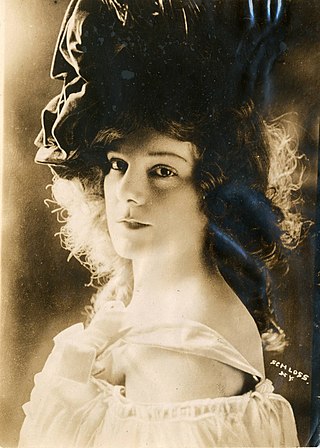Related Research Articles

The Shubert Organization is a theatrical producing organization and a major owner of theatres based in Manhattan, New York City. It was founded by the three Shubert brothers — Lee, Sam, and Jacob J. Shubert — in the late 19th century. They steadily expanded, owning many theaters in New York and across the United States. Since then it has gone through changes of ownership, but it is still a major theater chain.

Marcus Loew was an American business magnate and a pioneer of the motion picture industry who formed Loew's Theatres and the Metro-Goldwyn-Mayer film studio (MGM).

John C. Rice, born John C. Hilberg, was an American born Broadway stage actor and vaudevillian who is credited with performing the first onscreen kiss with May Irwin in 1896 for the Thomas Edison film company film The Kiss. The film was a 47-second recreation of a scene from the Broadway play The Widow Jones starring Irwin and Rice.
Harry Steppe, March 16, 1888 – November 22, 1934 was a Russian Jewish-American actor, musical comedy performer, headliner comedian, writer, librettist, director and producer, who toured North America working in Vaudeville and Burlesque. Steppe performed at several well-known theaters on the Columbia, Mutual and Orpheum circuits. Steppe was one of Bud Abbott's first partners.
The Cultural District is a fourteen-square-block area in Downtown Pittsburgh bordered by the Allegheny River on the north, Tenth Street on the east, Stanwix Street on the west, and Liberty Avenue on the south.

The New Victory Theater is a theater at 209 West 42nd Street in the Theater District of Midtown Manhattan in New York City, near Times Square. Built in 1900 as the Republic Theatre, it was designed by Albert Westover and developed by Oscar Hammerstein I as a Broadway theater. The theater has been known by several names over the years, including the Belasco Theatre, Minsky's Burlesque, and the Victory Theatre. The theater is owned by the city and state governments of New York and leased to nonprofit New 42, which has operated the venue as a children's theater since 1995. The New Victory presents theater shows, dance shows, puppet shows, and other types of performance art shows from all around the world.
The Fifth Avenue Theatre was a Broadway theatre in Manhattan, New York City, United States, at 31 West 28th Street and Broadway. It was demolished in 1939.

Virginia Earle was an American stage actress remembered for her work in light operas, Edwardian musical comedies and vaudeville over the decades surrounding the turn of the 20th century.
The American Music Hall, also known as the American Theater until 1908, was one of the oldest Broadway venues. Located at 260 West 42nd Street, it was designed by the architect Charles C. Haight, with a capacity of 2,065. It opened on May 22, 1888.

Metropolis Theatre opened as a theater with 1,600 seats in 1893. It was converted to show motion pictures by 1914 as competition from the Bronx Opera House (1913) took hold. It was in the southwest of the area known as the Hub.

The Empire Theatre is a former Broadway theater at 234 West 42nd Street in the Theater District of Midtown Manhattan in New York City. Opened in 1912, the theater was designed by Thomas W. Lamb for the Hungarian-born impresario A. H. Woods. It was originally named for female impersonator Julian Eltinge, a performer with whom Woods was associated. In 1998, the building was relocated 168 feet (51 m) west of its original location to serve as the entrance to the AMC Empire 25, a multiplex operated by AMC Theatres, which opened in April 2000.

Jack Cameron, also known as Jack Kammerer, was an American actor, singer, and acrobatic comedian whose career spanned almost five decades. He appeared in vaudeville, burlesque, film, radio, and television. Cameron was best known for his vaudeville performances, first as part of the Kammerer & Howland musical comedy act, and later as a principal comedian on the Keith-Albee circuit. He appeared in several motion pictures and could be heard on WPRO (AM) radio as the “Singing Salesman.”

The Columbia Amusement Company, also called the Columbia Wheel or the Eastern Burlesque Wheel, was a show business organization that produced burlesque shows in the United States between 1902 and 1927. Each year, between three and four dozen Columbia burlesque companies would travel in succession round a "wheel" of theaters, ensuring steady employment for performers and a steady supply of new shows for participating theaters. For much of its history the Columbia Wheel promoted relatively "clean" variety shows featuring comedians and pretty girls. Eventually the wheel was forced out of business due to changing tastes and competition from its one-time subsidiary and eventual rival, the Mutual Burlesque Association, as well as cinemas and cruder stock burlesque companies.

The Victoria Theatre was a prominent American vaudeville house during the early years of the twentieth century. Theatre mogul Oscar Hammerstein I opened it in 1899 on the northwest corner of Seventh Avenue and 42nd Street, along New York City's Longacre Square. The theatre was closely associated with the Paradise Roof Garden above it, and the two venues came to be known collectively as Hammerstein's. The Victoria closed in 1915.
Isidore H. Herk was a burlesque manager who played a major role in the evolution of this entertainment before World War II. His show at the Gaiety Theatre, closed in 1941, was the last burlesque show on Broadway.

The Columbia Theatre was an American burlesque theater on Seventh Avenue at the north end of Times Square in Midtown Manhattan, New York City. Operated by the Columbia Amusement Company between 1910 and 1927, it specialized in "clean", family-oriented burlesque, similar to vaudeville. Many stars of the legitimate theater or of films were discovered at the Columbia. With loss of audiences to cinema and stock burlesque, the owners began to offer slightly more risqué material from 1925. The theater was closed in 1927, renovated and reopened in 1930 as a cinema called the Mayfair Theatre. It went through various subsequent changes and was later renamed the DeMille Theatre. Nothing is left of the theater.

The Anco Cinema was a former Broadway theatre turned cinema at 254 West 42nd Street, between 7th and 8th Avenues in Manhattan, New York City. It opened in 1904 and was originally named the Lew Fields Theatre. It continued to operate as a playhouse under various names until it was converted into a movie theatre in 1930. Its block was famous for its concentration of Broadway theatres turned cinemas. After World War II, the street declined and the Anco Cinema eventually became a pornography venue. It closed as a cinema in 1988 and was gutted for retail use. The building was demolished in 1997.

Fort George Amusement Park was a trolley park and amusement park that operated in the Washington Heights and Inwood neighborhoods of Upper Manhattan, New York City, in the late 19th and early 20th centuries. It occupied an area between 190th and 192nd Streets east of Amsterdam Avenue, within present-day Highbridge Park.

Olympic Theatre was the name of five former 19th and early 20th-century theatres on Broadway in Manhattan and in Brooklyn, New York.
The Circle Theatre was a Broadway theatre, concert hall, movie theatre, and venue for vaudeville and burlesque located at the corner of Broadway and West 60th Street. It was the first theatre built in the Columbus Circle area of Manhattan. Its address was 1825 Broadway.
References
- ↑ "THIS WEEK'S NEW BILLS; OPENING OF A HANDSOME NEW EAST SIDE THEATRE. Frank Murtha's Murray Hill Theatre Will Be Dedicated by the Mayor and the Bostonians Will Produce a New Comic Opera There". The New York Times . October 18, 1896. p. 11.
- ↑ Digital Collections, The New York Public Library. "(cartographic) Bounded by Lexington Avenue, E. 57th Street, Avenue A, E. 54th Street, First Avenue (East River), and E. 40th Street, (1897)". The New York Public Library, Astor, Lenox, and Tilden Foundations. Retrieved August 5, 2023.
- ↑ Brown, Thomas Allston (1903). "Murray Hill Theatre". A History of the New York Stage, Vol. 3. New York: Dodd, Mead and Company. pp. 614–619.
- ↑ Loew's 42nd Street Theatre. Museum of the City of New York . Retrieved August 4, 2023.
- 1 2 Don B. Wilmeth, Tice L. Miller (1996). "Murray Hill Theatre". The Cambridge Guide to American Theatre. Cambridge University Press. p. 296. ISBN 9780521564441.
- ↑ Ruth Crosby Dimmick (1913). "Murray Hill Theatre". Our Theatres To-day and Yesterday. H. K. Fly Company. p. 65.
- ↑ Theatrical Licenses Granted. May 7, 1908. p. 5309.
{{cite book}}:|work=ignored (help) - ↑ Will Rogers, Steven K. Gragert, M. Jane Johansson (1996). The Papers of Will Rogers: From vaudeville to Broadway : September 1908-August 1915. University of Oklahoma Press. p. 181. ISBN 9780806133157.
{{cite book}}: CS1 maint: multiple names: authors list (link) - ↑ Bloom, Ken (1996). "Gay New York". American Song: A-S. Schirmer Books. ISBN 9780028645735.